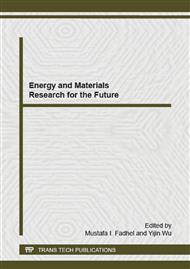p.142
p.148
p.154
p.163
p.167
p.173
p.178
p.183
p.188
Identification of Solar Cell Temperature Model Using Differential Evolution Algorithm
Abstract:
Establishing a general and precise solar cell temperature model is of crucial importance for photovoltaic system modeling and the loss analysis of output power and conversion efficiency. Based on the complex mechanism of solar cell temperature, this paper studies the steady state estimation model of solar cell temperature. Firstly, based on the approximate linear relationship of air temperature, solar radiation intensity, wind speed and solar cell temperature, the polynomial model of solar cell temperature is established and the unknown parameters of the model are extracted with the differential evolution algorithm. Secondly, Experimental acquisition platform is built to reduce the effects of air humidity solar incidence angle on the PV cell temperature. Finally, it shows that the estimated steady-state model is reliable and it fits better performance than other literature submitted through the experimental comparison.
Info:
Periodical:
Pages:
167-172
Citation:
Online since:
February 2015
Authors:
Price:
Сopyright:
© 2015 Trans Tech Publications Ltd. All Rights Reserved
Share:
Citation:


